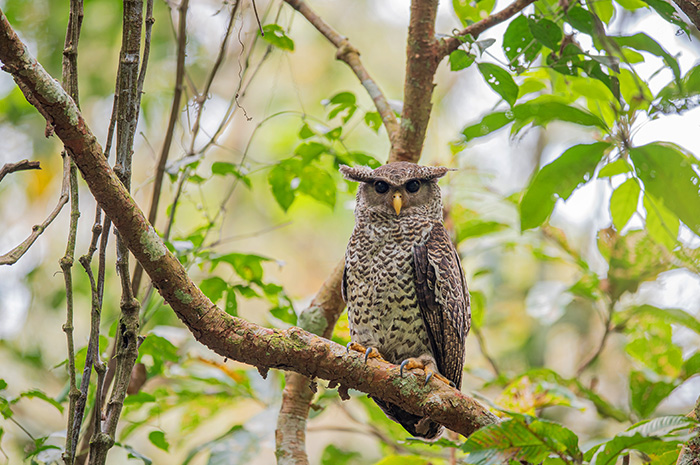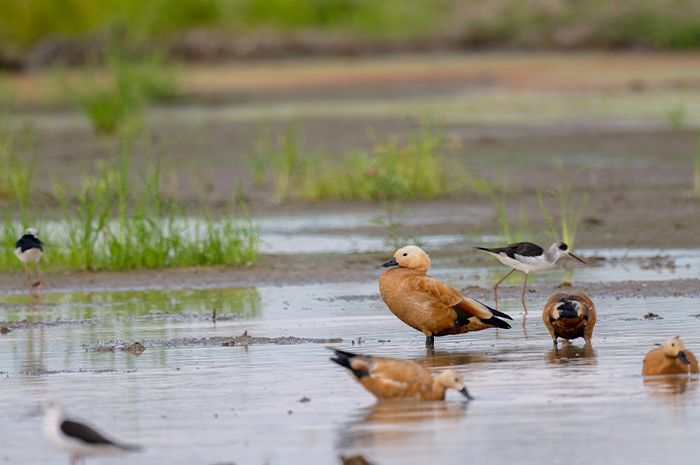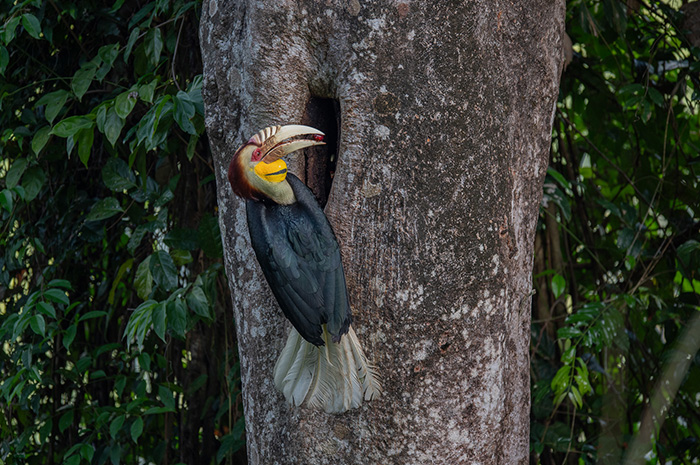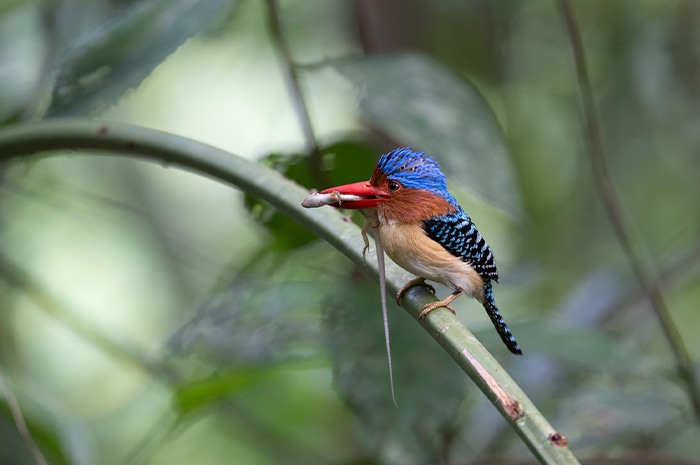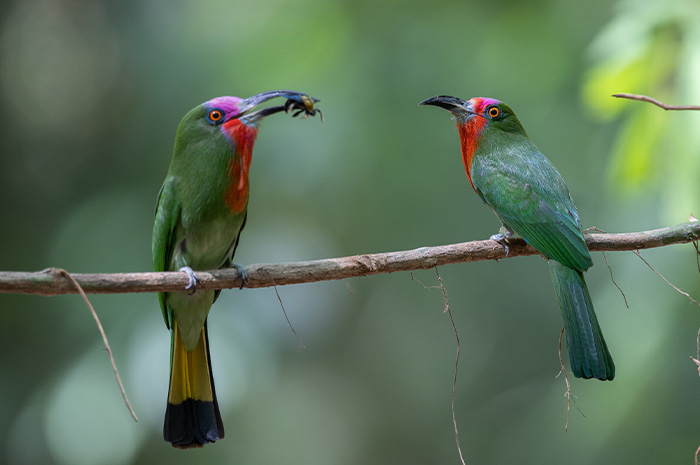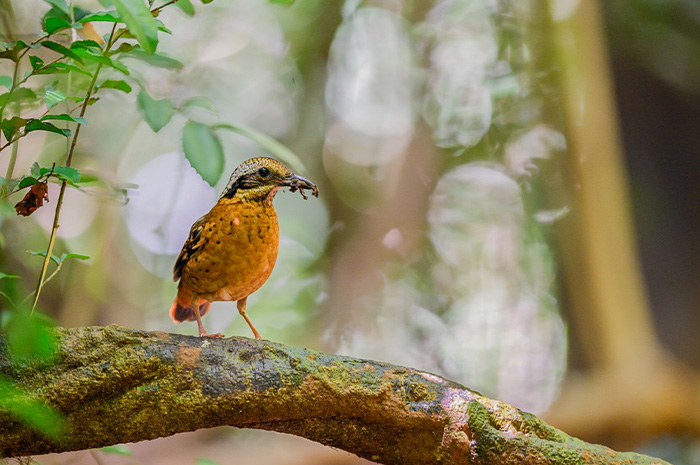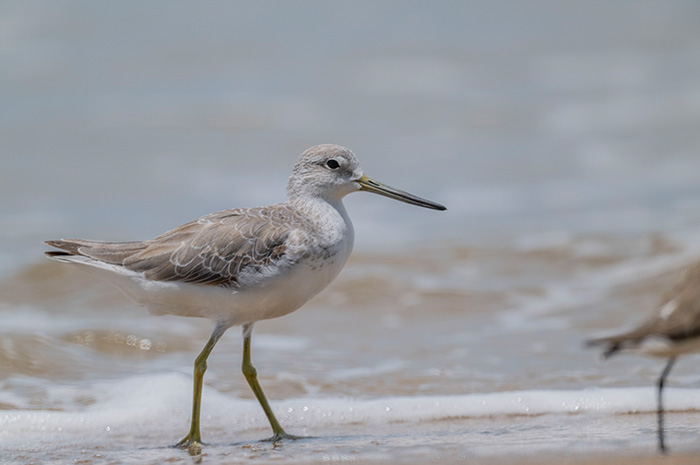the Phetchabun mountain range which is separated the central plain from the northeastern plateau. On the southwestern rim of the central, there is the Tenasserim mountain range in Phetchaburi Province which form the boarder line between Thailand and Myanmar. Below Bangkok, it encompasses with a shallow bay called “the Inner Gulf of Thailand”, where the intertidal mudflat occurs extensively from the east to the west of the inner gulf and it is the country single most critical habitat for migratory shorebirds and waterbirds.
Two major national parks that we will focus in the central include Khao Yai and Kaeng Krachan National Park. Other birding sites that we will also explore comprise of Limestone mountain in Saraburi Province, Pak Thale salt-pans, Laem Phak Bia sand spit, rice fields and wetlands in Phetchaburi Province. Khao Yai National Park is the first established national park in Thailand. Khao Yai together with other adjacent national parks and forest reserves were declared as a UNESCO World Heritage Site in 2005, which called Dong Phayayen-Khao Yai Forest Complex. Khao Yai NP is the most visited park in Thailand as its location is not far from Bangkok and the park contains very good facilities for tourists. It is also well-known for the great place for birds and wildlife watching. Kaeng Krachan National Park is the largest park in the country and declared as a UNESCO World Heritage Site in 2021. It renowned for its high diversity of birds and wildlife, many birders named it “the capital of Thailand birdwatching”. Its location is a conjunction point between the upper and the lower part of the country. The high season for birding in this park extends longer than other parks in Thailand. However, tourist facility in this park is completely different from Khao Yai NP, it is very limited as the whole area is a very steep mountain and caught much less attention from tourists. There is only one road go through the park from the entrance to the top peak, a first half of the road is a good paved road but a second half is a rough and steep dirt road. Pak Thale salt-pans is situated along the shoreline of the Inner Gulf of Thailand, it is one of the country largest traditional salt production area. These salt-pans are well-known as the international important site for migratory shorebirds in Southeast Asia, where it is a suitable wintering site for some of critically endangered species such as Spoon-billed Sandpiper and Nordmann’s Greenshank (over 10% of global population of Nordmann’s Greenshank wintering in the inner gulf of Thailand), as well as considerable numbers of many other shorebirds. Laem Phak Bia sand spit located nearby Pak Thale salt-pans, it holds other few species of rare shorebirds that restricted to a sand bar habitat. We must take a boat through mangroves to get to this sand spit, on the boat we can also connect with more species inhibit the mangroves too. Rice fields in Phetchaburi Province are also very interesting to explore, some of birds that spend their winter in rice paddies is a critically endangered species such as Yellow-breasted Bunting. Rice paddies are apparently a fabulous habitat that holds a high diversity of birds, hang around for few hours in this habitat can be very productive afternoon.
Northern Thailand is a mountainous region with many picturesque national parks. It is a cooler climate area of the country where pristine pine forests and montane forests occur at higher elevation. Some mountains with over 2,000 meters peaks created unique habitats for many high altitude species that could not find in other places in Thailand. Dry-dipterocarp and mixed deciduous forest dominated lower elevation area and foothills below 800 meters. Rice fields and lakes at low land areas are also good habitats for many appealing migrant and resident species. Thereby, northern Thailand offering a great selection of spectacular and sough-after Southeast Asian species, along with a huge array of migrants from the northern hemisphere.
When we are in the north we will focus only birding destinations in Chiang Mai Province, where many country top birding sites are located not too far apart from each other. The main destinations as following; Doi Inthanon National Park, the highest peak of the country at 2,565 meters above sea level where a unique habitat occurs and home to some of locally endemic birds that restrict to this habitat. The park has an altitudinal gradient of forest types that created diverse habitats for many spectacular species. Doi Ang Khang situated on the border between Thailand and Myanmar. It is a steep mountain with a breathtaking panoramic view. Even though majority of forest areas on Doi Ang Khang have been encroached and converted to agriculture areas, but some are remain in healthy condition, as well as acceptable amount of regenerating forests. Thus, it is surely still excellent for birding. Doi San Ju and Doi Lang, they are located on the same mountain ridge right on the border of Thailand and Myanmar. Doi San Ju is on the west side of the mountain ridge and Doi lang is on the east side, but the road that connects these 2 places was blocked by the Thai army for a safety reason. So, getting to birding spots on these places we have to take the road from different side of the ridge in different district. Then, we will explore Doi San Ju for one day and strike out for Doi Lang on another day. Tham Pha Plong Temple, a peaceful and beautiful Buddhist temple situated at the outer perimeter of Doi Chiang Dao, a huge limestone mountain complex and declared as UNESCO Biosphere Reserve. Rice fields in Fang district will be a place for relax and easy birding before sunset on the day that we are exhausted from long travel or a big day birding on the mountain. Many common species yet appealing to see can be found in this habitat.
Please look at the itinerary for expected species that we stand a high chance to see at each destination. Birds name mentioned in the itinerary are not 100% guarantee.
Itinerary
Day 1: Kok Kham Salt-pans and rice fields in Phetchaburi Province
Pick up from the hotel in Bangkok at early morning around 5.30 am. Travel to Kok Kham Salt-pans in Samut Sakorn Province, searching for our main target here, a critically endangered species Spoon-billed Sandpiper. Other shorebirds and waterbirds we can see here include Black-tailed Godwit, Great Knot, Red Knot, Curlew Sandpiper, Broad-billed Sandpiper, Marsh Sandpiper, Greater Sand Plover, Lesser Sand Plover, Red-necked Stint, Common Greenshank, Common Redshank, Black-winged Stilt, Grey Plover, Pacific Golden Plover, Brown-headed Gull, Whiskered Tern, Common Tern, Little Tern, Little Cormorant, Indian Cormorant, Painted Stork, Grey Heron, Great Egret, Intermediate Egret, Little Egret and more.
After check in at the hotel, around 4.00 pm. we will head off to the rice field. Spend 2 hours in the rice paddies we can connect with Yellow-breasted Bunting (Critically Endangered Species), Baya Weaver, Asian Golden Weaver, Amur Stonechat, Grey Wagtail, Pied Fantail, Greater Coucal, Asian Koel, Oriental Reed Warbler, Freckle-breasted Woodpecker, Asian Pied Starling, Black-collared Starling, White-breasted Kingfisher, Zebra Dove, Spotted Dove, Red-turtle Dove, Asian Palm Swift, Germain’s Swiftlet, Black Drongo, Brown Shrike, Plain Prinia, Yellow-bellied Prinia, Little Green Bee-eater, Blue-tailed Bee-eater, Streak-eared Bulbul, Scaly-brested Munia, White-rumped Munia, and Plain-backed Sparrow.
Meals: B / L / D
Overnight: Sun Hotel
Day 2: Pak Thale Salt-pans and Laem Pak Bia Sand Spit
After breakfast at the hotel, strike out for Pak Thale salt-pans, the country best and the most well-known shorebirds habitat. This morning can be very productive for many shorebirds and waterbirds include Nordmann’s Greenshank, Spoon-billed Sandpiper, Asian Dowitcher, Eurasian Curlew, Eurasian Whimbrel, Bar-tailed Godwit, Black-tailed Godwit, Great Knot, Red Knot, Curlew Sandpiper, Broad-billed Sandpiper, Terek Sandpiper, Marsh Sandpiper, Greater Sand Plover, Lesser Sand Plover, Red-necked Stint, Common Greenshank, Common Redshank, Spotted Redshank, Black-winged Stilt, Grey Plover, Pacific Golden Plover, Ruddy Turnstone, Brown-headed Gull, Caspian Tern, Whiskered Tern, Common Tern, Little Tern, Little Cormorant, Indian Cormorant, Painted Stork, Grey Heron, Great Egret, Intermediate Egret, Little Egret and so on.
After lunch, we will take a boat through mangrove to Laem Phak Bia sand spit to find special shorebirds that restricted to this tiny sand spit, the increasingly scarce Malaysian Plover and the recently elevated White-faced Plover. Other species in the mangroves and on the sand spit such as Collared Kingfisher, Black-capped Kingfisher, Brahminy Kite, Chinese Egret (a rare waterbird), Javan Pond Heron, Striated Heron, Sanderling and Lesser Crested Tern. More species that we might come across on the way from one spot to another such as Wood Sandpiper, Common Sandpiper, Long-toed Stint, Pied Avocet, Asian Openbill, Spotted Dove, Zebra Dove, Red Turtle Dove, Little Green Bee-eater, Blue-tailed Bee-eater, Black Drongo and Oriental Magpie Robin. Late afternoon travel to our resort tonight, Baan Maka Nature Lodge.
Meals: B / L / D
Overnight: Baan Maka Nature Lodge
Day 3: Kaeng Krachan National Park
Leave the lodge early morning around 5.30 am. with a packed breakfast to strike out for one of the country best birding site. We will ride 4WD truck straight up to the top peak of the park at km.30, Panoenthung Campground. The highlight on this peak is a Ratchet-tailed Treepie, a locally endemic to only this peak, you cannot find this bird in other place in Thailand. Stroll around the peak and down to km.27 might stand a chance to see at least one of them. Other birds that we can connect with around this area include Great Hornbill, Collared Babbler, White-browed Scimitar-babbler, Great Barbet, Blue-throated Barbet, Greater Green Leafbird, Banded Kingfisher, Lesser Racket-tailed Drongo, Hair-crested Drongo, Grey Treepie, Red-headed Trogon, Flavescent Bulbul, Black-crested Bulbul, Mountain Bulbul, White-browed Shrike-babbler, Verditer Flycatcher, Dark-sided Flycatcher, Rufous-browed Flycatcher, Black-winged Cuckoo-shrike, Long-tailed Broadbill, Orange-bellied Flowerpecker, Streaked Spiderhunter, Rufous-fronted Babbler, Yellow-bellied Babbler, White-rumped Shama and many more.
Meals: B / L / D
Overnight: Baan Maka Nature Lodge
Day 4: Kaeng Krachan NP
After light breakfast at the lodge head back to the park again, but today we will explore the low land section of the park. Birding along side the road can be very productive for Oriental Pied Hornbill, Great Hornbill, Tickell’s Brown Hornbill, Crested Serpent Eagle, Black-thighed Falconet, Greater Flameback, Greater Yellownape, Great Slaty Woodpecker, Greater Racket-tailed Drongo, Bronzed Drongo, Ashy Drongo, Asian Barred Owlet, Dollarbird, Indochinese Roller, Sultan Tit, Black-and-Red Broadbill, Black-and-Yellow Broadbill, Banded Broadbill, Silver-breasted Broadbill, Orange-headed Trogon, Golden-crested Myna, Hill Myna, Black-crested Bulbul, Black-headed Bulbul,Stripe-throated Bulbul, Ochraceous Bulbul, Vernal Hanging-parrot, Blue-winged Leafbird, Great Iora, Blue-eared Barbet, Green-eared Barbet, Coppersmith Barbet, Blue-bearded Bee-eater, Chestnut-headed Bee-eater, Asian Fairy Bluebird, Common Flameback, Crimson Sunbird, Ruby-cheeked Sunbird and many more.
After lunch, we will spend our afternoon in a bird hide outside the park. Birds that can be seen in the hideout include Green-legged Partridge, Bar-backed Partridge, Ferruginous Partridge, Grey Peacock-pheasant, Blue Pitta, White-crested Laughingthrush, Lesser Necklaced Laughingthrush, Greater Necklaced Laughingthrush, Emerald Dove, Racket-tailed Treepie, Siberian Blue Robin, Puff-throated Babbler, Brown-cheeked Fulvetta, Black-naped Monarch, Hill Blue Flycatcher, Indochinese Blue Flycatcher, Black-crested Bulbul, Black-headed Bulbul, Stripe-throated Bulbul and so on.
Meals: B / L / D
Overnight: Baan Maka Nature Lodge
Day 5: Kaeng Krachan NP to Khao Yai National Park via Bangkok
Head back to the low land section in Kaeng Krachan NP again, spend this morning hunting for more species that we still miss.
Get back to the lodge for lunch, then hit the road again for long travel to Khao Yai National Park.
Meals: B / L / D
Overnight: Fortune D2 Plus Khaoyai
Day 6: Khao Yai National Park
This morning we will heading to the top peak of the park and search for the top of the most wanted list of Khao Yai, the elegant Silver Pheasant and the Thai national bird Siamese Fireback. There is a well maintain board walk near the top peak that we can take a short walk and then we will birding down along the road from the higher elevation to the lower areas. Today can be very productive for Red-headed Trogon, Orange-breasted Trogon, Banded Kingfisher, Common Green Magpie, Oriental Pied Hornbill, Great Hornbill, Blue-bearded Bee-eater, Long-tailed Broadbill, Silver-breasted Broadbill, Black Eagle, Red Junglefowl, Green-billed Malkoha, Hill Blue Flycatcher, Mountain Bulbul, Ashy Bulbul, Black-crested Bulbul, Puff-throated Bulbul, Grey-eyed Bulbul,Black-headed Bulbul, Common Iora, White-browed Scimitar-babbler, White-crested Laughingthrush, Black-throated Laughingthrush, Heart-spotted Woodpecker, Blue Whistling-thrush, Orange-headed Thrush, Thick-billed Green Pigeon, Mountain Imperial Pigeon, Brown-backed Needletail, Hair-crested Drongo, Greater Racket-tailed Drongo, Ashy Drongo, Black-winged Cuckoo-shrike, Scarlet Minivet, Ashy Minivet, Red-wattled Lapwing, Ashy Wood-swallow, Indochinese Roller, Crested Serpent Eagle, Grey Wagtail, Blue Rock Thrush, White-rumped Shama, Verditer Flycatcher, Taiga Flycatcher, Grey-headed Canary Flycatcher, Brown Shrike, Olive-backed Sunbird, Spotted Dove, Zebra Dove and many more.
Meals: B / L / D
Overnight: Fortune D2 Plus Khaoyai
Day 7 : Khao Yai National Park
Today we will visit more birding spots in the park such as camp sites and a waterfall. We will search for those spicies that we still miss from yesterday such as Wreathed Hornbill, Austen’s Brown Hornbill, Sultan Tit, Green-eared Barbet, Blue-throated Barbet, Blue-eared Barbet, Coppersmith Barbet, Chestnut-headed Bee-eater, Golden-fronted Leafbird, Blue-winged Leafbird, Sulphur-breasted Warbler, Pin-striped Tit Babbler, Yellow-vented Flowerpecker, Cambodian Flowerpecker, Black-naped Oriole, Greater Flameback, Asian Fairy Bluebird, Paddyfield Pipit, Olive-backed Pipit, Vernal Hanging-parrot, Red-breasted Parakeet, Bar-winged Flycatcher-shrike and many more.
Optional : In the afternoon, in case of we still missing some of our main target species and not productive enough, we will travel to the other forest reserve near Khao Yai NP. This place is a pristine dry-dipterocarp forest where we might see more species inhabit very dry habitat.
Meals: B / L / D
Overnight: Fortune D2 Plus Khaoyai
Day 8 : Limestone Mountain in Saraburi Province to Nakorn Sawan Province
Leave the hotel for limestone mountain in Saraburi Province, search for the country endemic species, Rufous Limestone Babbler. Other birds also can be found here such as White-rumped Shama, Coppersmith Barbet, Ashy Drongo, Black Drongo, Taiga Flycatcher, Asian Brown Flycatcher and so on. Then, travel to Nakorn Sawan Province. After check in at the hotel, around 4.30 pm. we will visit a small wetland not far from the hotel where we might connect with White-breasted Waterhen, Little Pratincole, Asian Openbill, Yellow Bittern, Cinnamon Bittern, Chinese Pond Heron, Purple Heron, Grey Heron, Black-winged Stilt, Little Cormorant, Indian Cormorant, Little Ringed Plover, Chestnut-capped Babbler, Plain Prinia, Scaly-breasted Munia, White-rumped Munia, Chestnut Munia, Grey Wagtail, Streak-eared Bulbul, Yellow-vented Bulbul, Malaysian Pied Fantail, White-breasted Kingfisher, Taiga Flycatcher, Asian Brown Flycatcher, Hainan Blue Flycatcher and more.
Meals: B / L / D
Overnight: Mai Hom Resort Hotel
Day 9 : Bung Boraphet Lake and travel to Chiang Mai Province
After breakfast at the hotel, around 6.30 am. leave for Bung Boraphet Lake. We will cruise around the lake by local boat for few hours. This morning in the lake can be productive for Lesser Whistling Duck, Cotton Pygmy Goose, Little Grebe, Glossy Ibis, Black-headed Ibis, Oriental Darter, Striated Grassbird, Pheasant-tailed Jacana, Bronze-winged Jacana, Grey-headed Swamphen, Common Moorhen, Common Coot, White-browed Crake, White-breasted Waterhen, Common Snipe, Pin-tailed Snipe, Little Cormorant, Indian Cormorant, Great Egret, Intermediate Egret, Little Egret, Cattle Egret, Grey Heron, Purple Heron, Black-crowned Night-heron, Chinese Pond Heron, Black-winged Stilt, Red-wattled Lapwing, Pacific Golden Plover, White-breasted Kingfisher, Black-capped Kingfisher, Common Kingfisher, Plaintive Cuckoo, Asian Koel, Greater Coucal, Asian Golden Weaver, Baya Weaver, Amur Stonechat, Barn Swallow, Red-rumped Swallow, Eastern Marsh Harrier, Pied Harrier, and more. Other ducks that have been seen in the lake, some year they are present but some year they are not, such as Common Pochard, Baer’s Pochard, Garganey, Northern Shoveler, Indian Spot-billed Duck, Northern Pintail, Ruddy Shelduck etc.
After the boat trip around the lake, we will spend about an hour along the path near the pier where it is a reed habitat occur. Birds that we might find here include Chestnut-capped Babbler, Yellow-bellied Prinia, Oriental Reed-warbler, Thick-billed Reed-warbler, Black-browed Reed-warbler, Lanceolated Warbler and so on. Travel to Chiang Mai after lunch, it will be a long ride.
Meals: B / L / D
Overnight: Sakulchai Place Hotel
Day 10 : Tham Pha Plong Temple and rice paddies in Fang district
Around 5.30 am., leave the hotel for Tham Pha Plong Temple, located at the foothill of a huge limestone mountain of Doi Chiang Dao. The walk up to the temple we can connect with Orange-breasted Trogon, Pin-tailed Green-pigeon, Thick-billed Green-pigeon, Annam Limestone Babbler, Black-hooded Oriole, Greater Racket-tailed Drongo, Hair-crested Drongo, Asian Fairy Bluebird, Coppersmith Barbet, Red-whiskered Bulbul, Black-crested Bulbul, Sooty-headed Bulbul, Black Bulbul, White-headed Bulbul, White-crested Laughingthrush, Greater Necklaced Laughingthrush, Lesser Necklaced Laughingthrush, Green-billed Malkoha, White-rumped Shama, Verditer Flycatcher, Grey-headed Canary Flycatcher, Blue Rock Thrush, Puff-throated Babbler, Pin-striped Tit Babbler and many more. After lunch heading to the hotel in Fang district, check in and relax.
At 4.00 pm. start birding again at the rice paddies nearby the hotel. Birds we might see in this habitat such as Amur Stonechat, Pied Bushchat, Little Green Bee-eater, Brown Shrike, Long-tailed Shrike, Scaly-breasted Munia, White-throated Kingfisher, Common Kingfisher, Paddyfield Pipit, Ashy Wood-swallow, Asian Pied Starling, Black-collared Starling, Great Myna, Common Myna, Oriental Magpie Robin, Chinese Pond Heron and Cattle Egret.
Meals: B / L / D
Overnight: Tangerine Ville Hotel
Day 11 : Doi Ang Khang
Leave the hotel around 6.00 am, then traveling up the mountain to Doi Ang Khang. We will spend this morning visit several birding spots on this mountain that can be productive for Giant Nuthatch, Chestnut-vented Nuthatch, Crested Finchbill, Flavescent Bulbul, Brown-breasted Bulbul, Striated Bulbul, White-headed Bulbul, Dark-backed Sibia, Rufous-backed Sibia, Grey-capped Woodpecker, Stripe-breasted Woodpecker, White-browed Shrike-babbler, Burmese Shrike, Long-tailed Shrike, White-browed Scimitar-babbler, Silver-eared Mesia, Maroon Oriole, Black-hooded Oriole, Ashy Drongo, Scarlet Minivet, Long-tailed Minivet, Short-billed Minivet, Cook Swift, Japanese Tit, Black-winged Cuckoo-shrike and many more.
In the afternoon we will visit a botanical garden in the Royal Project where we can connect with Spot-winged Grosbeak, Gould’s Sunbird, Black-throated Sunbird, Green-tailed Sunbird, Streaked Spiderhunter, Annam Limestone Babbler, Yunnan Fulvetta, Blue-winged Minla, Black-breasted Thrush, Chestnut-thrush, Grey-winged Blackbird, White’s Thrush, Dark-sided Thrush, and several species of White-eye. Head back to the hotel around 5.00 pm.
Meals: B / L / D
Overnight: Tangerine Ville Hotel
Day 12 : Doi San Ju
Leave the hotel very early at 4.30 am. for the feeding spot on Doi San Ju, then set up a portable bird hide and wait for many species show up at sunrise. Because of limited space at the spot, so there is a very high competition on this spot among other groups of birders and photographers. This spot is the easiest place in Thailand to see Mrs Hume’s Pheasant (one of the world rarest Pheasant) at point-blank range. Other species often occurring at this spot are Mountain Bamboo Partridge, White-browed Laughingthrush, Rusty-cheeked Scimitar-babbler, Giant Nuthatch, Chestnut-vented Nuthatch, Ultramarine Flycatcher, Rufous-gorgetted Flycatcher, Olive-backed Pipit, Grey Bushchat, and Long-tailed Shrike. We might spend around 2-3 hours at this feeding spot, then we will move on slowly along the road and also stop at few more feeding spots that no need of setting up a portable bird hide again. Birds that we might see during the rest of the day such as Himalayan Cutia, Spot-breasted Parrotbill, Scarlet-faced Liocichla, Rufous-bellied Niltava, Large Niltava, White-bellied Redstart, Siberian Rubythroat, Black-throated Bush Tit, Chestnut-bellied Rock-thrush, Blue Whistling-thrush, White-browed Shrike Babbler, Yunnan Fulvetta, Golden Babbler, Golden-throated Barbet, Hume’s Treecreeper, Grey Treepie, Slaty-blue Flycatcher, Hill Prinia, Lesser Yellownape, Long-tailed Broadbill and many more.
Meals: B / L / D
Overnight: Tangerine Ville Hotel
Day 13 : Fang thermal spring and travel to Doi Inthanon National Park
Leave hotel early around 6.00 am. for Fang thermal spring, it is one of the most famous tourists attraction in Fang district and worth visiting. Strolling around hot springs and a stream nearby can be productive for Asian Barred Owlet, Spot-winged Grosbeak, Coppersmith Barbet, Lineated Barbet, White-faced Jay, White Wagtail, Grey Wagtail, Ashy Minivet, Scarlet Minivet, Rosey Minivet, Grey Bushchat, Black-crested Bulbul, Black-headed Bulbul, Stripe-throated Bulbul, White-capped Water-redstart, Common Kingfisher, Blue-bearded Bee-eater, Greater Coucal, Black-hooded Oriole, Black-naped Oriole, Greater Racket-tailed Drongo, Black-winged Cuckooshrike, Green-billed Malkoha, Barn Swallow, Striated Swallow, White-crested Laughingthrush, White-rumped Shama, Blue Rock-thrush, Blue Whistling-thrush, Little Pied Flycatcher, Taiga Flycatcher, Verditer Flycatcher, Hume’s White-eye, Chestnut-flanked White-eye, Oriental Magpie Robin, Olive-backed Sunbird, Streaked Spiderhunter, Oriental Honey Buzzard and many more.
Get back to the hotel before lunch to pick up our luggages, then travel to Doi Inthanon National Park. If we arrived Doi Inthanon NP before sunset, we will check out the lower elevation area inside the park where a dry-dipterocarp forest occur and searching for Collared Falconet. Other species that we might see here such as Black-headed Woodpecker, Lineated Barbet, White-faced Jay, Red-billed Blue Magpie, Sooty-headed Bulbul, and White-rumped Falcon.
Meals: B / L / D
Overnight: Mr. Daeng Bird Center Resort
Day 14 : Doi Inthanon National Park
After breakfast around 6.30 am., travel straight up to the top peak of the park, which is also the highest peak of Thailand at 2,565 meters above sea level. This peak has the unique habitat of the higher elevation peat bog surrounded by very pristine cloud forest called “Ang Ka Peat Bog”, it is the only one in the country. We will take slow paces on a well-maintain boardwalk goes around this miraculous peat bog in a loop. Spending few hours in this boardwalk and also around the top peak can be very productive for Doi Inthanon Sunbird (a locally endemic sub-species), Gould’s Sunbird, Ashy-throated Warbler (a locally endemic species), White-browed Shortwing, Snowy-browed Flycatcher, Slaty-bellied Tesia, Pygmy Cupwing, Rufous-throated Partridge, Dark-sided Thrush, Yellow-bellied Fairy Fantail, Yellow-bellied Flowerpecker, Davison’s Leaf Warbler, Rufous-winged Fulvetta, Silver-eared Laughingthrush, Dark-backed Sibia, Chestnut-tailed Minla, Blue-winged Minla, Eye-browed Thrush, Grey-sided Thrush, Speckled Wood Pigeon, Ashy Wood Pigeon and so on. Then, we will travel down to the mid-elevation area where we might connect with Slaty-bellied Tesia, Lesser Shortwing, White-gorgetted Flycatcher, Hume’s Treecreeper, White-throated Fantail, Yellow-bellied Fairy-fantail, Black-eared Shrike-babbler, Clicking Shrike-babbler, Mountain Bulbul, and Lesser Racket-tailed Drongo.
After lunch, we will go to a stream near electric power generation station and also visit a nearby waterfall behind the Royal Project. Birds that we might bump into at this area include White-capped Water-redstart, Plumbeous Redstart, Pygmy Cupwing, Streaked Wren-babbler, White-crowned Forktail, Slaty-backed Forktail and so on.
Head back to the resort around 6.00 pm.
Meals: B / L / D
Overnight: Mr. Daeng Bird Center Resort
Day 15 : Doi Inthanon National Park to the airport
We will spend our last morning to explore more new species around the park’s second checkpoint, here we can stroll along the road and also light trek in the short forest trail called “Jeep track”. This morning might productive for Long-tailed Minivet, Short-billed Minivet, Grey-chinned Minivet, Little Pied Flycatcher, Mountain Tailorbird, Yellow-cheecked Tit, Rufous-backed Sibia, Chestnut-crowned Warbler, Chestnut-vented Nuthatch, Slaty-bellied Tesia and more. After lunch leave Doi Inthanon for Chiang Mai airport.
Meals: B / L
Optional : You can add one more day in this itinerary, then it will be 15 days tours, by adding an extra day in Doi Inthanon National Park. Because of the park is a huge place, there are more birding spots left to explore. Moreover, there are also bird hideouts made by hill tribes people in the park. On the extra day you can spend sometime in one or two of these bird hideouts. It might increase number of species in your trip checklist and also provide you an opportunity to see some beautiful birds at point-blank range.
Note: The itinerary is indicative only, it is subject to change according to the situation. The
main destinations might swap around and more extra birding spots can be added. The accommodation mentioned above can be changed in case of no room available by the time you are booking the tour. We are totally flexible to adjust any option in the program to deliver you a bespoke itinerary. Discuss with us to customize the itinerary that best suit you.

